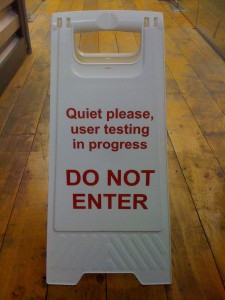As UX Designers, our challenge is to help clients figure out out how to delight customers with an intentional, informed online user experience – one that works on any device and improves business results. It’s a great gig, but it’s also really hard.
In my experience, the only way to confirm if a design is on the right track is to test it with real people. It’s the only way to know if a design really works or not. Nothing else comes close. Thankfully, many big-name companies and brands are starting to harness the power of real-world user testing by enlisting the help of low-cost remote usability testing services.
Over the years I’ve used these services as both a client and a tester, but I’ve learned the most by being an actual tester. In this post I’ll share how being a remote usability tester can help you develop and strengthen your empathy skills, which are super-important in all aspects of user experience design.
Enter UserTesting.com
UserTesting.com is a remote usability testing service based in Mountain View, CA. As a relatively young startup, they have developed quite a client base since launching in 2008. I’ve been a tester for them since 2010 and have tested dozens of sites and apps for some of the biggest companies and brands in the world. Using a crowd-sourced model, the company pays pre-qualified testers to try out new websites or smartphone apps and takes videos while they do so. Clients receive valuable user feedback within an hour at a very low cost.
Here’s how becoming a remote tester for a company like User Testing can make you a better UX Designer:
Remembering Design Fundamentals
User Testing has clients of all shapes and sizes, from micro businesses to big global brands. The smaller companies often need help with improving design fundamentals such as color, typography, use of white space, and a clear call to action. I provide this kind of design feedback when it’s appropriate and that helps me remember to keep the fundamentals in mind on my own projects.
Lots Of Designs
Sometimes it’s easy to to get lost in a particular project, especially if you’re doing a big job for a long-term client. Doing a 15-minute user test every day or two will expose you to lots of different design approaches. This can spark new solutions to the design problems you are currently working on.
Besides finished designs, more and more User Testing clients are testing early prototypes, conducting A/B design comparisons and focusing on specific sections of large sites. It’s a tremendous opportunity to participate directly in cutting-edge design projects vs. reading about them on design blogs.
Lots Of Devices
These days we have to design for every conceivable viewport, even those we don’t necessarily know about yet. Besides conducting desktop computer tests, user testers can also evaluate apps and sites on a variety of iOS and Android devices. This is a huge learning opportunity if you are involved in creating responsive web designs, and you get paid for it. Win win win.
You’ll Feel Their Pain
For me, the most valuable aspect of being a user tester is that I really feel a user’s pain when something doesn’t go well. For example, I recently completed a test for a well-known company that asked me to test their existing old-school website on an iPad. It was the most difficult test yet.
Since I was using an iPad mini, tasks that might have worked on a full-sized iPad were impossible to complete on the mini’s smaller screen. While I completed the full test in about 20 minutes, I told the client that an average consumer would probably have bailed out of the experience much earlier. I never want anyone to experience the type of frustration I did while using that site, and that feeling has stayed with me ever since.
Your Design Responsibility
That testing experience really drove home the notion that now more than ever, designers have a huge responsibility to provide a useful and engaging customer experience for any digital device. But how on earth do we do it? Like I said, it’s hard. Lots of really smart people are trying to crack that nut as we speak. You’re probably one of them 🙂
The ever-expanding plethora of devices in all shapes and sizes demands that we engage real users as early and often as possible. As Luke Wroblewski, author Mobile First likes to say, “We have much to learn – and much to unlearn”.
What about you? I encourage you to sign up as a tester for User Testing or a similar remote testing service and see if it helps you become a more empathetic UX designer. Let me know how it works out in the comments.
Get the proposal

Signup for email updates and get the same proposal I've used to close over $100k in consulting business.

No comments yet.